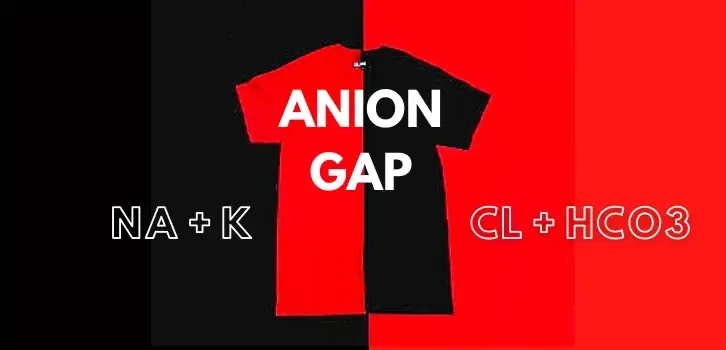What is anion gap and How to interpret it?

Let us warm up with Some question first!
Anion gap and ABG scenarios are commonly asked in OSCE examinations. This post is focused on understanding Anion gap in detail and bedside approach to anion gap.
Let us start with few OSCE questions to warm up and then try to understand Anion gap in the easiest possible way, step by step!
Station 1: A patient is admitted to the ICU with the following lab values: BLOOD GAS in room air shows pH: 7.199, PCO2: 32.2, HCO3: 12, PO2: 86.6. Electrolytes are: Na: 136, K: 4, Cl: 103. Calculate the anion Gap.
Anion gap 21, can the answer be 25 also, if we include K in the calculation? Read the post in detail to avoid confusion in ExamStation 2: Your patient is a 8-year-old boy admitted with DKA with acute renal injury, bloods investigation are as PH 7.12, PaCo2 12 mm Hg, HCO3 is 5 meq/l. Na is 140 meq, K is 4 meq and Cl is 115. What is the anion gap in this patient, choose correct options.
a.Anion gap is 14 and indicates he has metabolic alkalosis.
b.Anion gap is 20 and he has respiratory acidosis.
c.Anion gap is 21 and he has high anion gap metabolic acidosis.
d.Anion gap is 25 and he has normal acid-base status.
Anion gap is 21 and he has high anion gap metabolic acidosis. But whether there is sufficient data to say that? can there be a mixed non anion gap metabolic acidosis? Read below in detail for explanation.
Station 3: Anion gap is calculated as follow, choose correct option. Station 2: Your patient is a 8-year-old boy admitted with DKA with acute renal injury, bloods investigation are as PH 7.12, PaCo2 12 mm Hg, HCO3 is 5 meq/l. Na is 140 meq, K is 4 meq and Cl is 115. What is the anion gap in this patient, choose correct options.
a.[ K+ ] - [ HCO3- + CL- ]
b.[ Na+ ] + [ HCO3- + CL- ]
c.[ Na+ ] - [ HCO3- + CL- ]
d.[Na+ + K+ ] - [ HCO3- + CL- ]
Both 3 and 4 are correct, but which one to choose in exams? Read below
What is Anion gap?
Anion gap is the difference between Positively Charged Ions (Cations) and Negatively Charged Ions (Anions). well, that is very simple!
But ...
The law of electro-neutrality states that each atom in a stable substance has a charge close to zero therefore the negative charges (Anions) must be equal to positive charges (Cations) [ Linus Pauling 1948 ]
The body must balance the difference between major cations Na+ and major anions Cl- on either side by using Compensatory buffers like negatively charged bicarbonate and positively charged protons.
Imagine the body as a large pool of water with an abundance of H+ and OH- ions. When the body tries to maintain this electro-neutrality during various pathologies, it has to do so by making alteration in the H+ and OH- ions concentration, thereby resulting in ALTERED PH.
So abnormal PH is a result, not the effect. In reality, the body is just trying to maintain stable chemistry by trying to equalize the charges on both sides by changing readily available ions like HCO3.
This clearly establishes two facts:
1. Abnormal PH is not a cause but a result. So treating the PH cannot be the solution to the problem
2. Bicarbonate should not be in the center of understanding and treating acid-base disorders. (Unless the pathology is a loss of bicarbonate)
( I will strongly recommend reading Stewart's approach to acid-base disorder as against Handerson Hasselback's, after all its just an equation which calculate PH based on H+ and OH- )
Why a normal anion gap is not zero if the body Follows the law of electro-neutrality
Because The Anion Gap is the Gap between the MEASURED and not the total anions and cations.
Since our ability to test ions in ABG is limited to Na+, K+ Cl-, HCO3- (at least in past). This leaves a gap representing the number of unmeasured anions and cations. However, most of the new ABG's have electrolytes, albumin, and ketones as well.
Where from the concept of anion gap originates?
This is very important to understand as it opens more dimensions in utilizing anion gap other than just using it to differentiate between types of metabolic acidosis.
Acid-base pioneer James L. Gamble, created Gamblegrams (see the image below) which helps to understand the broader utility of the anion gap.

Looking at the Gamblegram, try to imagine that whenever one ion will increase ( eg chloride), the other ion ( eg HCO3-) will decrease to squeeze-in the additional chloride causing what we call hyperchloremic acidosis or whenever HCO3 is lost via urine, Cl- has to increase to maintain the neutrality of total charges.
In the same way, when new acids will start accumulating say lactate or ketones, the bicarbonate has to decrease to accommodate causing lactic acidosis in sepsis or ketoacidosis in DKA.
Gambelgram shows a significant presence of albumin on the negative charge side and therefore albumin is very important while interpreting anion gap metabolic acidosis, this is explained below.
The anion gap is a small application of Gamblegram and in my view is unnecessarily kept limited to metabolic acidosis as Gamblegram also can be applied to explain conditions such as metabolic alkalosis in the same way.
How Anion gap is calculated?
There are two ways of calculating anion gap
- [Na+] - [Cl−] + [HCO3] Or
- [Na+] [K+] - [Cl−] + [HCO3]
Hence in OSCE station 3, both the answers are correct. However Its better to choose the first option
Because potassium concentrations in serum is relatively low, it usually have little effect on the calculated gap in blood. Therefore, not using potassium is widely accepted, however its not wrong.
In U.S., anion gap is calculated as [Na] – ([Cl] + [HCO3]) and while in UK and also Australia the anion gap is calculated as ([Na] + [K]) – ([Cl]+[HCO3])
The important point is if you using the K, the normal range of anion gap should be 12-20 mEq/L and if you are not considering K then it should be 8 to 16.
Which formula we should use in OSCE?
I will go ahead and calculate the anion gap without using K.
When to use Anion gap?
In metabolic acidosis, to decide whether the metabolic acidosis is due to increased acid production: eg sepsis or intake: eg. salicylate) against decreased acid excretion: eg RTA or loss of HCO3– : eg renal or GI losses.
Let us simplify
Acidosis is a result of these three factors
- Increased production or intake
- Decreased excretion of acid
- Loss of bicarbonate
Increase acid will give rise to a high anion gap
Decrease acid excretion or loss of bicarb will produce normal anion gap

(Further reading: Urinary anion gap is very important and helps to differentiate between a GI and renal cause of a normal anion gap acidosis )
Are there disorders with low anion gap?
Rare but yes, Read here
How to use anion gap in the differential diagnosis of metabolic acidosis?
| High Anion gap metabolic acidosis (HAGMA). | Normal Anion gap metabolic acidosis (NAGMA) |
|---|---|
Add CAT to MUDPILES in 2020
|
(CAGE)
|
There is an interesting article published in Lancet, a new anion gap mnemonic for the 21st century: GOLD MARK, which points out the limitation of MUDPILES. MUDPILES is a cliche, isn't it?
Why you should consider Albumin while interpreting anion gap
Anions gap in a healthy individual depends heavily on serum phosphate and serum albumin which represent a larger proportion of unmeasured negative charges especially albumin which contributes almost the whole value of normal anion gap
Hence Hypoalbuminemia is a leading cause of reduced anion gap and may falsely lead to diagnosis non anion gap metabolic acidosis while in actuality the patient has anion gap metabolic acidosis. This is especially important in the PICU setting.
How do you treat anion gap?
Additional things to consider while calculating anion gap
Recommended reading!
- GambleGram
- Stewart principle of acid-base analysis
- Urinary anion gap
References:
FOAMed Resources:
- Renal Fellow Network: Low Anion Gap
- Life in the Fast Lane: Anion Gap
Other:
- Oh MS, Carroll HJ. The anion gap. N Engl J Med. 1977 Oct 13;297(15):814-7. doi: 10.1056/NEJM197710132971507. PMID: 895822.
- Electrolytes: Common Questions: What is anion gap?". Lab Tests Online. American Association for Clinical Chemistry. Albert, M., Dell, R., and Winters, R. (1967).
- Quantitative Displacement of Acid-Base Equilibrium in Metabolic Acidosis. Annals of Internal Medicine, 66 (312-322). doi: 10.7326/0003-4819-66-2-312 Gamble JL (1947)
- Chemical anatomy, physiology and pathology of extracellular fluid; a lecture syllabus, edn 5 Cambridge: Harvard University Press
- The Nature of the Chemical bond, L. Pauling, 1960, 3d edition, pp. 172-173, 270, 273, 547 Cornell University Press, ISBN 0-8014-0333
- Schurmans, W., Lemahieu, W., and Frans, E. (2014). High anion gap metabolic acidosis: use the proper acronym, discard the red herrings and thou shall find the culprit. Clinical kidney journal, 7(3), 320–322.
Author

Ajay Agade | DNB(Pediatrics), FNB(Pediatric Intensive Care), Fellowship in Pediatric pulmonology and LTV
Ajay is a Paediatric Intensivist, currently working in Pediatric Pulmonology & LTV at Great Ormond Street Hospital NHS, London
💡 Join the Discussion!
🩺 Help us refine this article — share corrections or additional information below. Let's elevate the accuracy of knowledge together! 💉💬